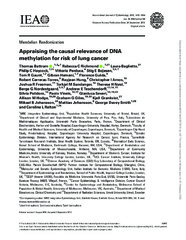Appraising the causal relevance of DNA methylation for risk of lung cancer
Permanent lenke
https://hdl.handle.net/10037/17543Dato
2019-09-24Type
Journal articleTidsskriftartikkel
Peer reviewed
Forfatter
Battram, Thomas; Richmond, Rebecca C.; Baglietto, Laura; Haycock, Philip C.; Perduca, Vittorio; Bojesen, Stig E.; Gaunt, Tom R.; Hemani, Gibran; Guida, Florence; Carreras-Torres, Robert; Hung, Rayjean; Amos, Christopher I.; Freeman, Joshua R.; Sandanger, Torkjel M; Nøst, Therese Haugdahl; Nordestgaard, Børge G.; Teschendorff, Andrew E.; Polidoro, Silvia; Vineis, Paolo; Severi, Gianluca; Hodge, Allison M.; Giles, Graham G; Grankvist, Kjell; Johansson, Mikael B.; Johansson, Mattias; Smith, George Davey; Relton, Caroline L.Sammendrag
Methods - We first performed a meta-analysis of four epigenome-wide association studies (EWAS) of lung cancer (918 cases, 918 controls). Next, we conducted a two-sample Mendelian randomization analysis, using genetic instruments for methylation at CpG sites identified in the EWAS meta-analysis, and 29 863 cases and 55 586 controls from the TRICL-ILCCO lung cancer consortium, to appraise the possible causal role of methylation at these sites on lung cancer.
Results - Sixteen CpG sites were identified from the EWAS meta-analysis [false discovery rate (FDR) < 0.05], for 14 of which we could identify genetic instruments. Mendelian randomization provided little evidence that DNA methylation in peripheral blood at the 14 CpG sites plays a causal role in lung cancer development (FDR > 0.05), including for cg05575921-AHRR where methylation is strongly associated with both smoke exposure and lung cancer risk.
Conclusions - The results contrast with previous observational and mediation analysis, which have made strong claims regarding the causal role of DNA methylation. Thus, previous suggestions of a mediating role of methylation at sites identified in peripheral blood, such as cg05575921-AHRR, could be unfounded. However, this study does not preclude the possibility that differential DNA methylation at other sites is causally involved in lung cancer development, especially within lung tissue.


 English
English norsk
norsk